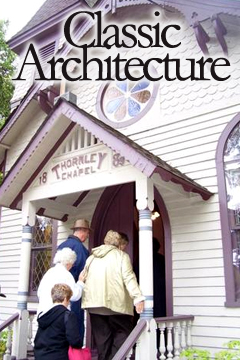Historic ocean Grove, NJ
On July 31, 1869, Reverend Osborn, Reverend Stokes, and other Methodist ministers camped at a shaded, well-drained spot on New Jersey's seashore and decided to establish a permanent Christian camp meeting community called "Ocean Grove."[11]
Drawing from the major population centers of New York City and Philadelphia, Ocean Grove became a popular destination during the growth of the camp meeting movement in post-Civil War America. Tents and an open-air wooden shelter, or tabernacle, were erected in the 1870s, for the trainloads of visitors arriving by the New York and Long Branch Railroad after 1875. In 1877 alone, 710,000 railroad tickets were sold for the Ocean Grove-Asbury Park train station.[4]
 |
in 1876 |
 |
Postcard of Ocean Grove Railroad Station, dated 1908 |
 |
The "North End Hotel" had 255 rooms and a saltwater pool |
A well was dug in the summer of 1870, near the site of the first tabernacle, to provide fresh water (the "Beersheba" well, named from a well in Israel mentioned in scripture, is still in existence).[4] A second, larger tabernacle was built in the 1880s, and permanent structures began to be constructed. Streets were paved and some were given Biblical names, such as "Pilgrim Pathway" and "Mt. Tabor Way".
As Ocean Grove drew more and more visitors, the second tabernacle was also outgrown, and construction of the present Great Auditorium was completed in 1894. Originally designed to accommodate crowds of as many as 10,000 people, the subsequent installation of theater-style cushioned seating in many sections reduced seating capacity to about 6,000. Regardless, it remains Ocean Grove's most prominent structure and the centerpiece of its summer programs (see more about the Auditorium further down the page). By the early 20th century, said theNew York Times in 1986, it was called the "Queen of Religious Resorts ... Visitors would travel miles to bask in the Victorian seaside splendor and to attend engaging, extroverted religious ceremonies. Millions of people, tourists and pilgrims both, made the trip to Ocean Grove every summer."[5]
Until Ocean Grove's municipal authority was folded into Neptune Township in 1981, it boasted a set of unique laws, including one that made it illegal on Sundays to have cars on the streets of Ocean Grove. This had a significant effect on the development of a close-knit community. People looking to get away for the weekend typically avoided the Grove (the beach was closed on Sunday, too). That meant the visitors were likely to be coming for a week-long visit or more. Most came to attend programs sponsored by the Camp Meeting.
President Ulysses S. Grant visited Ocean Grove during his time in office and made his last public appearance in this town. Other presidents to speak on the grounds include James Garfield, William McKinley, Teddy Roosevelt, Woodrow Wilson, and Richard Nixon. Heavyweight boxing champions James J. Corbett and Max Baer and department store magnate F.W. Woolworthwere among the celebrities of the day who vacationed in Ocean Grove.[4]
In 1975, Ocean Grove was designated a State and National Historic District as a 19th century planned urban community. It has the greatest extent of Victorian and early-20th century architecture in the United States.[4]
During the 1960s–1980s, the town declined along with much of the New Jersey seashore, and was pejoratively called "Ocean Grave" due to the general air of decrepitude and the elderly population.[12] But beginning in the 1990s, and through 2006, Ocean Grove experienced a dramatic increase in property values and a considerable revival in fortune, particularly with the restoration of older hotel structures, many of which had deteriorated into single room occupancy ("SRO") quarters. Also – as part of this resurgence – a number of sidewalk cafés and shops along Main Avenue (the main business thoroughfare) now cater to visitors and seasonal residents.
However, as David Willis of the Asbury Park Press reported in a February 15, 2008, article, “For the year, the median (home) sales price fell 1.5 percent in 2007...”. The article also quoted economist James Hughes, dean of the Edward J. Bloustein School of Planning and Public Policy at Rutgers University, who stated, "The market was virtually flat...It suggests that the market is far from rebounding, and it may signal that there is weakness ahead."[13]
Plans were announced in 2006 for a major new hotel and condominium development on property which has been vacant since the 1970s, when the old North End Hotel – once Ocean Grove's largest – was damaged by fire and subsequently demolished in 1980.[14] These plans have become controversial though, and in January 2008 the Planning Board of Neptune stated the North End Redevelopment Proposal was "inconsistent with the town's Master Plan".[15]
SOURCE: WIKIPEDIA




